Contributory members are able to log private notes and comments about each site
Sites Anne T has logged. View this log as a table or view the most recent logs from everyone
Robin Hood's Well (Chollerton)
Date Added: 4th Sep 2014
Site Type: Holy Well or Sacred Spring
Country: England (Northumberland)
Visited: Yes on 3rd Sep 2014. My rating: Condition 1 Ambience 2 Access 4

Robin Hood's Well (Chollerton) submitted by Anne T on 4th Sep 2014. Walking across the field from the footpath from the B6342 to Well House Farm, this is the first view of Robin Hood's Spring/Holy Well. [I double checked the grid reference to ensure I had the right place].
(View photo, vote or add a comment)
Log Text: Robin Hood's Well, Colwell, Northumberland: I last visited Colwell on 13th June 2014, when we went in search of the old chapel (located in someone’s back garden, so not accessible without permission), the two wells in the centre of the village – Coley’s Well and Pricky’s Well – and Blue Crags Hill Fort (also known as Brecken Hills Fort).
Both Coley’s Well and Pricky’s Well are at the eastern edge of the village at the cross-roads where the northern most side-road from the A68 leads eastwards to meet the B6342. Whilst part of the area’s rich history, neither well is pleasing to the eye (very similar to Meg’s Well in Aydon). They sit alongside a small stream, the Coal Burn.
About 200 yards south of the village is a third well, Robin Hood’s Well. As this is recorded as a holy spring, I was keen to see this, so stopped off whilst I was passing by.
There is parking in a layby by the road junction mentioned above, near to Pricky’s Well. From here, it is a 200 yard walk south down the B6342 to the footpath which leads eastwards towards Well House (grid reference: NY 96641 74198. This is a very busy little road, with no footpaths, so I had to keep stepping up onto the grass verges to avoid the traffic.
Robin Hood’s Well is almost on the field boundary next to the road. To reach it, on opening the gate to the field by the footpath sign, you need to turn right immediately and walk 50 yards or so to the south (towards the woodland). The first view is of a post sticking up from marsh grass, which looks like a fence post. As you get closer, you will see a stone lying next to the post. A closer look shows a pool of water around the post and stone, and boggy ground surrounding it – a shame it is so unremarkable for such a historic well.
There is a further spring which appears 100 yards further south down the field, which has a clearer water course marked by stones on either side, but was dry (although the ground was very boggy) on the day of my visit.
At (or near) Well House Farm (according to the Hexham Courant and Visitor UK web sites) there is also a fourth sulphurous well, The Bore Well, reputed to improve fertility and which is well cared for with a proper housing.
Chesters Roman Site b
Date Added: 3rd Sep 2014
Site Type: Rock Art
Country: England (Northumberland)
Visited: Yes on 25th Aug 2014. My rating: Condition 4 Ambience 4 Access 4
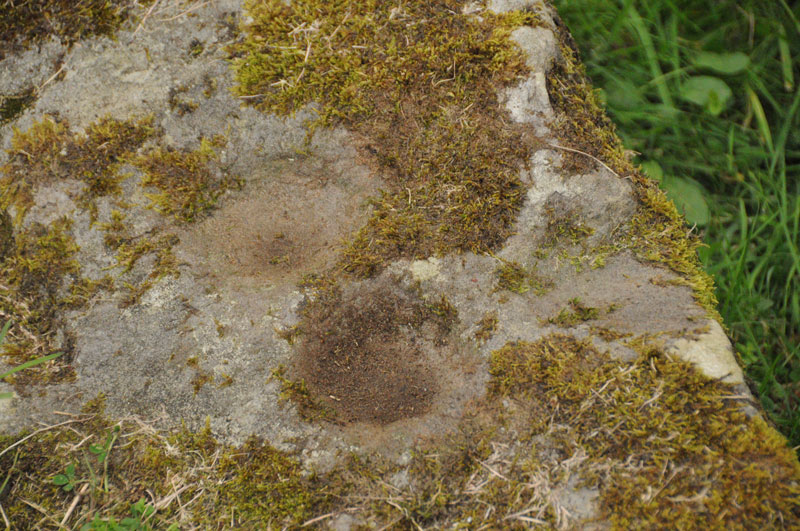
Chesters Roman Site b submitted by Anne T on 1st Sep 2014. Photograph showing two cup marks (0.09m) on stone, with third just on right hand edge.
(View photo, vote or add a comment)
Log Text: Chesters Roman Bridge Rock Art, Chollerford, Northumberland: Parking at the George Hotel at Chollerford on the north side of the river Tyne, we walked back over the bridge and found the small gate to the west side of the bridge to the footpath leading to the Roman Bridge. This is a really easy walk along a long straight footpath defined by wired fences on both sides (it feels like being a sheep being herded to a pen!). After a short kilometre, the path bears right down to the river, and a further gate lead to remains of two old Roman bridges on the same site. The ruins are impressive.
There seems to be some confusion about what rock art is at this site, and what isn’t. What is certain is that we found a stone block with three clear cup marks on in the location described by the England’s Rock Art record 769. Thank goodness we had the images of the location of this stone downloaded onto my phone, otherwise we would have spent hours searching the bridge piers.
This is a lovely location, right next to the Tyne, surrounded by old Roman remains. It would have been nice to have been able to see the other two stones purportedly found here, too.
There are also substantial remains of the bridges and other structures on the northern bank of the Tyne, which we'll go back and explore at some time in the future.
Our find was 'rewarded' with a drink at the hotel afterwards - this was a very pleasant early evening in late August.
Wall Crags Settlement
Date Added: 3rd Sep 2014
Site Type: Ancient Village or Settlement
Country: England (Northumberland)
Visited: Yes on 25th Aug 2014. My rating: Condition 2 Ambience 3 Access 4
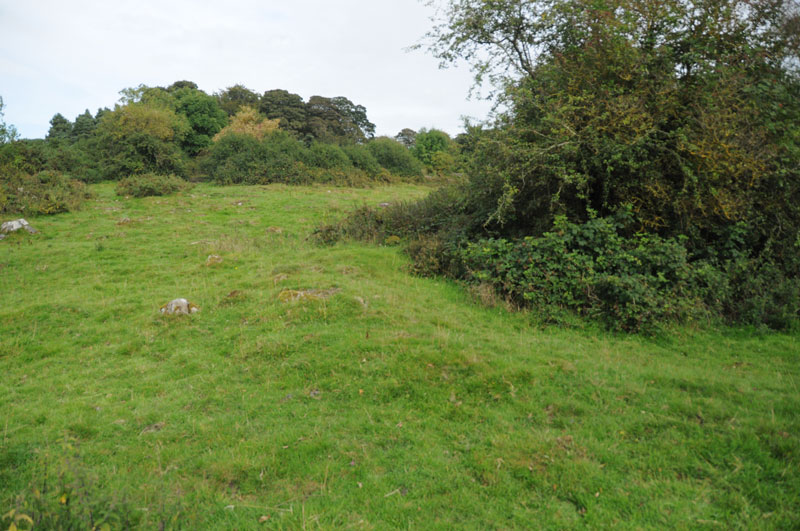
Wall Crags Settlement submitted by Anne T on 1st Sep 2014. To our untutored eye, the circular bank running from the centre of the photograph to the right hand side looked like the possible foundations of a roundhouse (now has trees growing in the middle).
(View photo, vote or add a comment)
Log Text: Wall Crags Settlement, Northumberland: It was 4pm on Bank Holiday Monday and we wanted to go somewhere, but didn’t have time to go far. Husband Andrew had spent the afternoonon the internet looking at rock art on the old Roman Bridges at Chollerford, and spotted the settlement to the east of Wall village as somewhere else to go on route. We drive through Wall on a regular basis, and neither of us had been aware of a settlement here until we looked closer at the map.
We parked on a side street just above the chapel in Wall at approx. grid reference NY 91744 69094, and walked down to the chapel, turning left towards the park. There were some very old cottages to our left hand side (on the walk back, I’m sure the one nearest the start of the footpath was dated 1642). The footpath took us across the southern end of the park, with a gate leading to some stone steps leading up the hill.
We climbed quickly up the steep slope, then the steps stopped, and open grassland began. The slope must have been about 40 degrees, and was slippery enough in the dry, and would have been lethal in the wet. I’m afraid I bottled out at this point - getting up would have been OK, but getting down (for me) would have been a nightmare, so I sat on the grass and handed the camera to Andrew, so he's to thank for the images on the Portal.
He was gone about 20 minutes, coming back to say it was fairly difficult to identify the features up on top of the hill, as whilst the top was level, there were trees, large stones and the ground looked as if it had been heavily trampled by cattle and was difficult to walk on. The ramparts were visible, as were the possible foundations of a couple of roundhouses.
I haven’t been able to find out much about this settlement at all, except for a brief mention on Keys To The Past (page reference N13760) which is a shame, but I’ll keep my eyes open for any information.
Weetwood Moor 3a
Date Added: 1st Sep 2014
Site Type: Rock Art
Country: England (Northumberland)
Visited: Yes on 31st Aug 2014. My rating: Condition 3 Ambience 5 Access 4
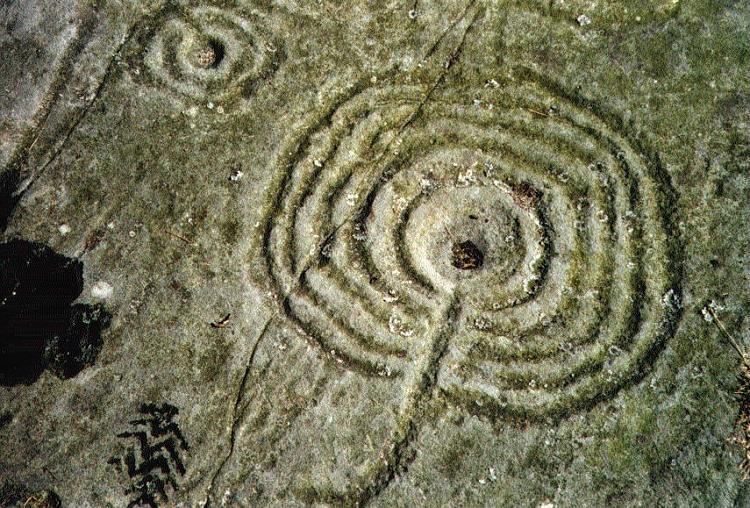
Weetwood Moor 3a submitted by rockartuk on 3rd Aug 2001.
(View photo, vote or add a comment)
Log Text: Weetwood Moor 3a (Bicycle Rock), Northumberland: My husband had seen photographs of the rock art at Weetwood Moor, which was very near the Fowberry Mains/Fowberry Park site we'd seen on 17th August 2014). Parking at the road junction next to where the metalled track runs alongside North Plantation, we walked down to find the footpath, which is located to the right hand side of the road, just passed the cattle grid. My goodness, was this overgrown for the first 20 to 30 metres – I stepped through head high bushes and gorse, eventually emerging into a rocky moorland.
After a 100 yards or so, the footpath bears left. There is a clear sign straight ahead, declaring ‘not access land’, but there was clear evidence of small footpaths carrying along across the heather. We went up a little way to try and see what was there, when a lady walking her dog sailed past us, waving and shouting ‘hello’ cheerfully as she went, so we assumed it was alright to carry on (we’ve since found a published Rock Art walk which takes us past the rocks we wanted to see).
Andrew found the Bicycle rock first of all – this was amazing - and I took photographs. To the east of this rock, someone had built a small cairn in a cup shape, this cup containing what looked like a Wiccan altar with sea shells, a bone and some berries.
Walking to the quarry face immediately to the east of Bicycle Rock, I noticed (for the first time) evidence of fluting on the edge of the rock, similar to the weathering on other standing stones in the area (ones that immediately spring to mind are Matfen and the Newtown Mill standing stone).
We found other rocks with cup marks, and I’ll need to sit down and compare my images to the other pages for Weetwood Moor on the Portal, to make sure I’m recording them against the right pages.
Tremaenhir Standing Stones
Date Added: 29th Aug 2014
Site Type: Standing Stones
Country: Wales (Pembrokeshire)
Visited: Yes on 22nd Aug 2014. My rating: Condition 3 Ambience 3 Access 5
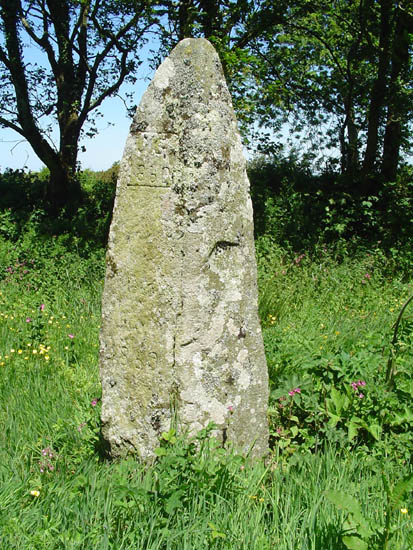
Tremaenhir Standing Stones submitted by PaulM on 6th Jun 2004. The village name suggests there are three standing stones in this village. This is the second of two marked on the OS map.
It is handily located on the grass verge so you can walk right up to it or view it from the comfort of your car seat.
This stone is located at SM827263 and has the initials "J.G." carved into it with the date 1860.
(View photo, vote or add a comment)
Log Text: Standing Stone by Tremaenhir, Pembrokeshire: After an amazing day at St. David’s Cathedral and Bishop's Palace, followed by St. Non’s Well, Chapel and standing stones, we were reluctant to call an end to the day, so we decided to drive along the A487, heading north to Tremaenhir Farm, where the map told us there were ‘Standing Stones’.
Just opposite the farm, there was a solitary tall standing stone, with only its top half poking above the undergrowth. We looked around for more, and couldn’t find any - although I did spot a tall shape in the bank opposite, which looked like it could have been a standing stone heavily covered by ivy.
It would be fun to go back in winter, when all the grass and weeds have died down, armed with the information and grid locations recorded here on the Portal.
St Non's Chapel
Date Added: 29th Aug 2014
Site Type: Early Christian Sculptured Stone
Country: Wales (Pembrokeshire)
Visited: Yes on 22nd Aug 2014. My rating: Condition 3 Ambience 4 Access 4
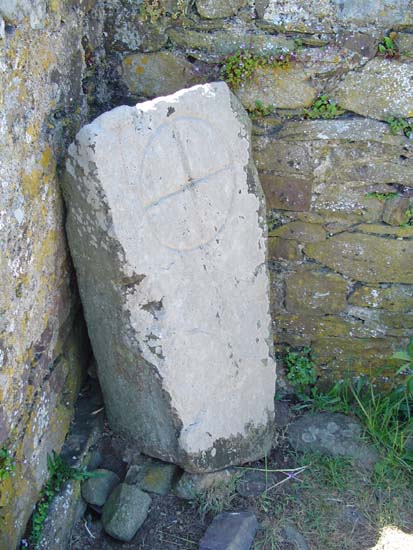
St Non's Chapel submitted by vicky on 7th Jun 2004. Within the ruined chapel of St Non's, around which are the remains of a possible stone circle, lies this inscribed stone. It is believed to date from the 7th-9th century AD and is decorated with a ring cross.
(View photo, vote or add a comment)
Log Text: St Non's Chapel, Pembrokeshire: A gate leading from between St Non’s Well (to our left) and the vault with her statue in (to our right), led into the field containing the chapel. It was a short walk to the ruined building, which is enclosed by a fence to protect it from the cattle in the field.
This chapel is very small, with an entrance to the west side. It is on a very steep site, and the walls to its southern side are composed of some impressively large stones.
Inside the chapel is a small white-painted cross, in the left hand corner as you face the sea. At its base are many offerings – tokens, tea-lights, a small memorial plaque and pebbles painted with people’s names.
Whilst we explored the stones in the field around the chapel, a Welsh family came and spent quite some time by the cross, and I wondered if they were laying their own offerings. This is certainly a superb spot to mediate and pray on a sunny day.
As we entered the field, it was apparent that there were some standing stones within the field, although I’d not seen these referred to until I logged onto the Portal when we got home. I’ve submitted some images of these along with the chapel.
St Non's Well (Pembrokeshire)
Date Added: 29th Aug 2014
Site Type: Holy Well or Sacred Spring
Country: Wales (Pembrokeshire)
Visited: Yes on 22nd Aug 2014. My rating: Condition 4 Ambience 4 Access 4
St Non's Well (Pembrokeshire) submitted by chestertourist on 27th Dec 2004. St Nons Well near St. David's.
(View photo, vote or add a comment)
Log Text: St Non's Well, Pembrokeshire: It was interesting trying to find the small road leading down to St. Non’s Chapel and Well; it turned out to be a side road off a side road, with a very, very narrow section coming out of St. David’s.
This road led down to St. Non’s Retreat Centre, with views over the sea. Just before the road reached the Retreat Centre, there was a small car park on the right hand side, with plenty of room for visitors, with only a short walk down to the well and chapel.
Approaching the well, my first view was a stone vault to the right hand side, with a white statue of a woman with her arms outstretched, and at first I thought this was St. Non’s Well. The actual well is a few steps further on to the left hand side. As we stepped down to see the source of the water, there was a continuous noise, like the well was connected to a blow hole at the bottom of the cliffs with the noise of the waves lapping at the entrance coming back up where we stood. We stood in silence, listening. “The well’s breathing!” I exclaimed. After a few more minutes, I realised that the noise came from the bullocks drinking from the small stream of water that emerged from the well into the adjacent field. Not a holy miracle after all, but it got the heart racing none-the-less.
We went onto explore St. Non’s Chapel and the standing stones in the same field, hopping onto the Coast Path (well my husband did – I couldn’t get over the stone stile in the south-western corner of the field, because of the proximity of the path to the drops down to the sea below). We watched a school of kayakers in the bay below, with blue sky and spectacular geology. I would have loved to have taken a flask of tea and just sat for a while taking this all in.
Whilst we were exploring the standing stones around the chapel, I noticed a family collecting water from the well.
Nevern Churchyard
Date Added: 29th Aug 2014
Site Type: Standing Stone (Menhir)
Country: Wales (Pembrokeshire)
Visited: Yes on 23rd Aug 2014. My rating: Condition 3 Ambience 4 Access 5

Nevern Churchyard submitted by PaulM on 19th Aug 2002. This standing stone inscribed with ogham can be found in Nevern churchyard close to the famous cross. Two other interesting stones, also descorated with ogham have been used as window sills inside the church.
(View photo, vote or add a comment)
Log Text: Nevern Churchyard, Pembrokeshire: After having felt ‘thwarted’ by the farmer’s notice to seek permission before accessing the Trafael Rock Art capstone (but with no details of who to contact) we cut our losses and drove back towards Newport to have a cup of tea and a piece of cake. We came across the pretty little village of Nevern. There was a crowd of people gathered around the bench and a large mounting block opposite the village hall river, so stopped to look. What a treat. A stream ran by the western end of the church, with a narrow well laid footpath above the stream, against the bottom of the church yard wall, so you could walk up to the little weir further upstream. According to the church guide book, the mounting block is only one of two left in Pembrokeshire.
The notice board by the bench told us that there was the remains of a castle, a church with two notable crosses, an old Pilgrim’s cross and other things to see. For today, we focused on the church where we found two ancient stone crosses, plus a stone with both Ogham and Latin inscriptions and an incised stone on the external wall of the church.
The church was atmospheric to start with, with its dark yew avenue. A lady was sitting on a tombstone under a yew tree immediately to the left of the gate, sketching, whilst her friend was recording and deciphering writing on tombstones nearby.
At first I couldn’t see the Great Cross, which was right next to the church wall, and partly hidden by the branches of the yew trees next to it. All four sides are heavily decorated with ribbons and interlacing symbols. The guide says the cross is 13 feet high, with the cross being 24.5 inches in diameter. Looking up to the top of the cross, the top seemed ‘too large’ for the shaft, as it protruded by at least an inch on each of the longer sides, and I wondered if these had been a ‘marriage’ but the styles of decoration matched perfectly.
Immediately to the east of the porch before entering the church is the Vitalianus Stone, which the guide book tells us may date from the 5th century, and also has Ogham and Latin inscriptions. On the church wall above the Vitalianus stone, there is an interesting weathered corbel of a male face.
On the north exterior wall of the church, at the left hand corner of the second window in the chancel, there is a lettered stone with a Latin inscription, which has apparently been recut.
Inside the church, as you look towards the east end from the nave, the nave seems to bend towards the south. The guide book says this is only a 1 degree angle, but actually seems a lot more.
There are a couple of very interesting and amusing memorials to members of the Warren family – one next to the Maglocunus Stone and the other in the west corner of the quire. The Maglocunus Stone is built into a window sill on the south side of the nave, and contains another example of Ogham and Latin inscriptions next to each other.
There was also a ‘weeping yew’ (second tree to the right as you entered the churchyard). The ‘bleeding’ limb was round the back of the tree (to the east), and really did weep a reddish liquid.
A couple of hours well spent, satisfying my interest for both church architecture and ancient monuments.
Gors Fawr Outliers
Date Added: 28th Aug 2014
Site Type: Standing Stones
Country: Wales (Pembrokeshire)
Visited: Yes on 23rd Aug 2014. My rating: Condition 3 Ambience 5 Access 4
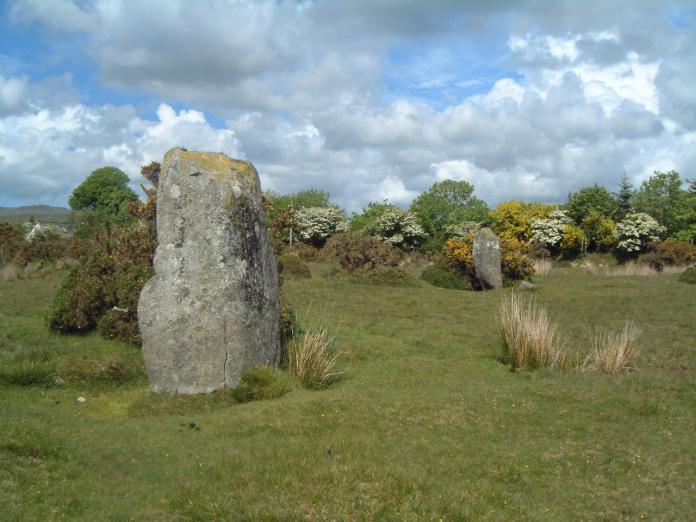
Gors Fawr Outliers submitted by enkidu41 on 3rd Jun 2004. These 6' and 5'7" stones lie 45' apart north-east of the circle. This shot proves that it's not always wet in Wales.
(View photo, vote or add a comment)
Log Text: Gors Fawr Outliers, Pembrokeshire: It was an easy walk of about 150 metres or so north-northeast across the moorland to the Gors Fawr Standing Stones/Outliers, which were visible from the stone circle.
Standing at the Outliers looking towards the circle, they do appear to be an entrance. We spotted other shaped stones lying in the grass, which looked like they may have formed part of a stone avenue at some point in the distant past.
One of the Outlier stones was shaped, as if it could be used to sit on. I understand from reading the Ancient Wisdom of Wales web site that this is called ‘the dreaming stone’ and has magnetic qualities.
With the Presili mountains in the background, I certainly had the sense of an ancient landscape with huge meaning for our ancestors, and wished I could tap into their thinking today.
I am interested in finding out about possible alignments between these Outliers, the circle and the Solstice – once I’ve processed all the photographs and notes I’ve taken from this trip!
Gors Fawr Stone Circle
Date Added: 28th Aug 2014
Site Type: Stone Circle
Country: Wales (Pembrokeshire)
Visited: Yes on 23rd Aug 2014. My rating: Condition 4 Ambience 5 Access 4
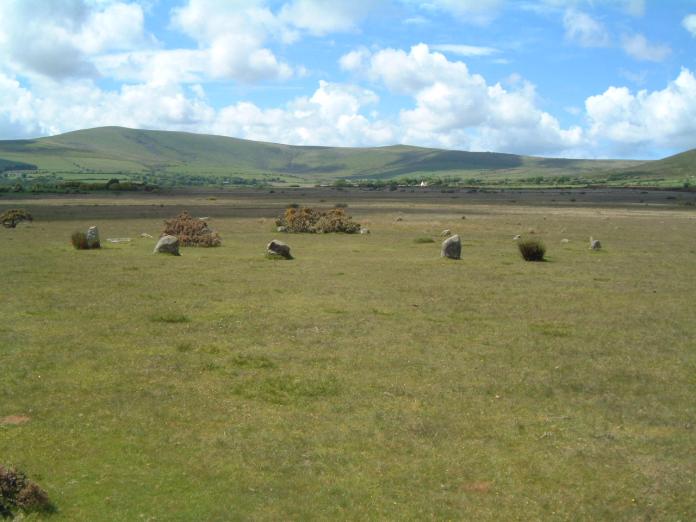
Gors Fawr Stone Circle submitted by enkidu41 on 3rd Jun 2004. A circle of 16 stones in an almost perfect 73’ diameter circle. This shot proves that it's not always wet in Wales.
(View photo, vote or add a comment)
Log Text: Gors Fawr Stone Circle, Pembrokeshire: After stopping off at St. Brynach’s church in Nevern to see the stone crosses, we started on our long journey home to Northumberland. We’d identified a number of ancient sites we wanted to see on our way back, including the Gors Fawr Stone Circle. My husband had hoped to see the site in the Presili Hills where they’d quarried the stones for Stonehenge, but time (and my horror of precipices and steep drops) wouldn’t allow – on our next trip, we’ll need to allow another month at least to see all the things we want to in the area!
Following the A478 and turning off towards Mynacholog-ddu at the village of Crymych, it was easy to find the little gem of Gors Fawr. Again, I hadn’t realised what a tourist attraction this was. There was a small lay-by across from the house ‘Pen-rhos’, and an easy walk across the field to the circle.
It was much smaller than I imagined from the photographs I’d seen on the Portal, but if I’m allowed to, I'd use the word ‘cute’ as the most accurate description that comes to mind. One of the first things I saw almost in the middle of the circle was a small Wiccan altar, made of small rounded blue pebbles, with its apex pointing towards the Gors Fawr Outliers.
Walking just outside the perimeter of the circle, we became aware of smaller stones buried in the grass at regular intervals about 3-4 metres outside the main circle, and wondered if there was an outer circle (but then there were so many other stones in the field that we let our imaginations run a little riot with ideas of stone avenues and tumuli). Since I've been home, I've read on the Ancient Wisdom of Wales web site that a survey had been done, and nothing found.
But what a place to build a circle – on a wide, flat plateau of moorland, with the Presili hills rising to the north. This stone circle seeming to lie in the centre of the graceful bowl formed by the hills, which rose up blue and misty in the distance. The circle somehow seemed to me to capture the essence and magnificence of the landscape.
There was a small, constant stream of other visitors. I got into conversation with a family who said they’d had trouble finding the circle, and had stopped by the Outliers and walked back. The man told us about the apparent alignments between the Outliers and the Circle at Solstice, so I’ll need to check this out. I didn't have the courage to ask him if he was another Portal user (but next time I won't be so shy!).
I would have loved to have stayed until sunset.
Tre-llwyn Fawr
Date Added: 28th Aug 2014
Site Type: Standing Stone (Menhir)
Country: Wales (Pembrokeshire)
Visited: Yes on 21st Aug 2014. My rating: Condition 3 Ambience 4 Access 4
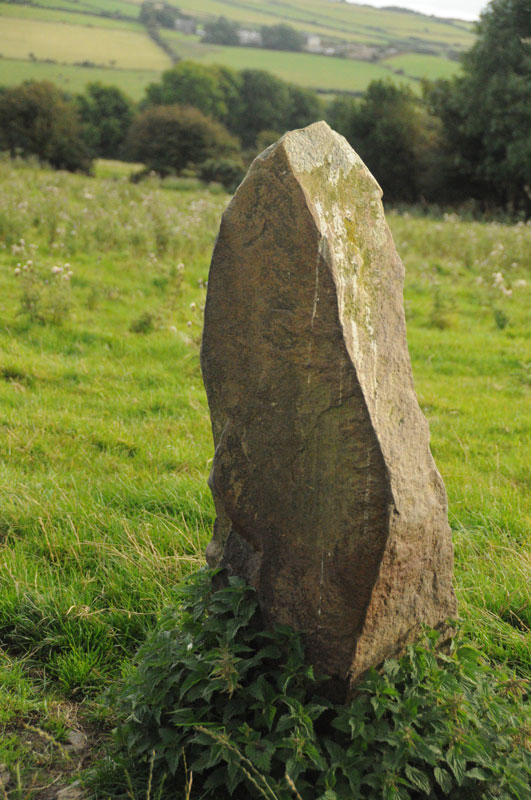
Tre-llwyn Fawr submitted by Anne T on 28th Aug 2014. Continuing the quick walk around the stone to look at it's other faces. There was a smaller stone buried in the grass to the west, but this hasn't been picked up the camera, as it lies too low to see clearly.
(View photo, vote or add a comment)
Log Text: Trellwyn-Fawr Standing Stone, Pembrokeshire: [We found more than one standing stone at this site, one of them not marked on the map, so I hope I am reporting them correctly – if I’ve confused them, please let me know so I can correct my entries (thank you!)].
On the way back to the road from the Trellwyn-Fach Standing Stone, we stopped off to look at this stone, which we'd first seen on the walk down. This stone stands alone in the middle of the field, with great views over the Cwm Gwaun valley below. It seems to fit the description on the Dyfed Archaeological Site, which describes this stone as 1.4 metres high by 1 metre wide at its base, leaning slightly to the north-north-west. Just to the west, there was another smaller stone poking through the grass.
The views to the north, east and west were blocked by hedges and trees, so it wasn’t really possible to appreciate the location this stone was set in.
Trellwyn-fach
Date Added: 28th Aug 2014
Site Type: Standing Stone (Menhir)
Country: Wales (Pembrokeshire)
Visited: Yes on 21st Aug 2014. My rating: Condition 3 Ambience 4 Access 3
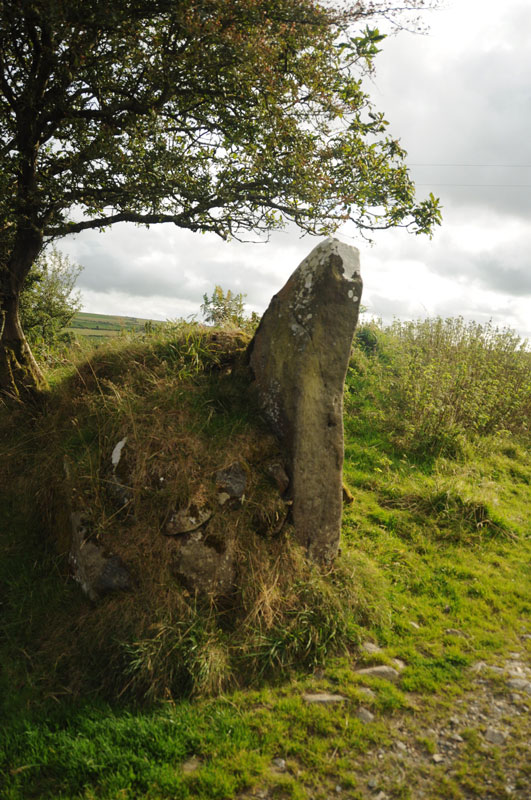
Trellwyn-fach submitted by Anne T on 28th Aug 2014. There were many larger stones buried in the banks defining the fields, and I wondered if this was another standing stone ....
(View photo, vote or add a comment)
Log Text: Trellwyn-Fach Standing Stone, Pembrokeshire: [We found more than one standing stone at this site, one of them not marked on the map, so I hope I haven't confused them – if I’ve got it wrong, please let me know so I can correct my entries (thank you!)].
From the Trewllyn-Fach Stone Pair, we walked along the footpath at the other side of the un-named farm (about 100 yards south west of the house called Trellwyn). This is essentially a farm-track and easy walking, past old farm properties which are being renovated. As the track turned a left hand corner just past the farm buildings, I spotted a standing stone in the middle of the field, but this wasn’t marked on the map, so intrigued, we continued onto Trellwyn-Fach.
The footpath went passed the standing stone towards the derelict Trellwyn-fach farmhouse, but there was a well-worn track across to the stone, so we crossed the bank forming the field boundary and followed the track to take a closer look at the stone. On the way, there was also another erratic stone in the field to the left hand side (I’ve not been able to get the grid reference as the images from UK Grid Finder are those of clouds, so I’m unable to make out the ground). The whole area is littered with large stones, possible cairns and what appear to be large erratic stones.
I wasn’t sure if the stone had broken and the broken piece been taken away, or if the rock had been deliberately quarried. This stone does indeed look like a pointing finger and there are good views over the Cwm Gwaun valley.
Trellwyn-fach Stone Pair
Date Added: 28th Aug 2014
Site Type: Standing Stones
Country: Wales (Pembrokeshire)
Visited: Yes on 21st Aug 2014. My rating: Condition 3 Ambience 3 Access 4

Trellwyn-fach Stone Pair submitted by Anne T on 28th Aug 2014. This photograph shows the two stones in context of their immediate landscape. The first stone is being used as the gatepost, the second is visible between the gatepost and the barns, more or less in the centre of the photograph.
(View photo, vote or add a comment)
Log Text: Trewynfach (Tre-llwyn Fawr) Stone Pair, Pembrokeshire: About 400 yards up the road from the Parc-y-meirw stones, just before reaching a house called Trellwyn, is an un-named farm to the south side of the road. On the map there are two standing stones marked, which stand very slightly to the west of the farm. Neither of the stones can be seen from the road. No-one appeared to be at the farm, and as the field gate was open, we walked along the field boundary for about 50 yards to see if we could spot them.
One of the stones has been used as a gatepost, in the field boundary between the farm and the first field to its west; the other is situated in the middle of the farmyard. Presumably the gatepost stone, which stands 1.4 metres high, has been relocated from its original site. The second stone is on private land, but looks taller than the stone being used as the gatepost.
I confess that after the Parc-y-Meirw stones and these, we looked at the gateposts of all the farms as we drove along, wondering if they were ‘recycled’ standing stones.
Parc y Meirw
Date Added: 28th Aug 2014
Site Type: Stone Row / Alignment
Country: Wales (Pembrokeshire)
Visited: Yes on 21st Aug 2014. My rating: Condition 3 Ambience 4 Access 4

Parc y Meirw submitted by PaulM on 24th Aug 2001. PARC Y MEIRW STONE ROW, Pembrokeshire
NGR: around SM99893591 (Landranger map 157/Outdoor Leisure North Pembrokeshire map (No 35))
Four stones remain of this row - two of which make up gateposts - the other two are upright in the hedge that borders the road. The Outdoor Leisure North Pembrokeshire map marks only three but two further stones are located ~300m to the south east. Other stones can be seen or make up the roadside bank.
The gateposts look quite square unlike the other two s...
(View photo, vote or add a comment)
Log Text: Parc-y-meiry standing stones, Pembrokeshire: After having visited the Llanllawer Holy Well, we set off eastwards up the road towards Trellwyn farm, where there were two sets of standing stones marked on the southern side of the road.
Driving slowly up this single track lane, trying to look over the tall banks and fences rising above us on either side of the road to spot the stones, a tall standing stone by a field gate suddenly appeared, looming above us from the grass verge – impressive!
We stopped the car in the gate entrance and hopped out to take a look. Only the large stone There was nothing in the field, so we unlatched the field gate to take a closer look.
Unusually, I haven’t been able to find out much about these stones, apart from a short entry on the Royal Commission on the Ancient and Historical Monuments For Wales, where the stones are referenced as SAM PE126.
Hogtivis Stone
Date Added: 28th Aug 2014
Site Type: Early Christian Sculptured Stone
Country: Wales (Pembrokeshire)
Visited: Yes on 23rd Aug 2014. My rating: Condition 3 Ambience 4 Access 4
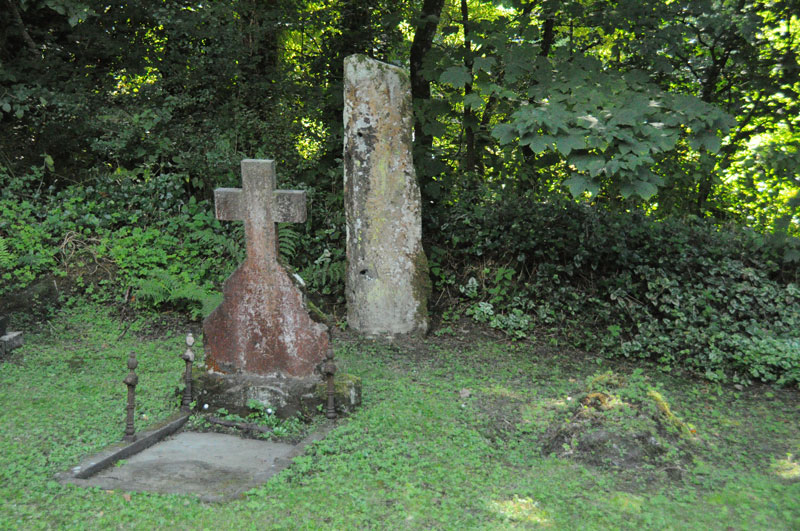
Hogtivis Stone submitted by Anne T on 25th Aug 2014. Photograph showing the location of the Hogtivis Stone from the west end of the church. It is nestled snuggly against the boundary bank of the church yard and the car park, between grave stones.
(View photo, vote or add a comment)
Log Text: Intrigued by just the word ‘Stone’ on the map, we drove from Garnturne burial chamber towards Sealyham Bridge, looking for the church next to ‘The Stone’. There are just a few farms and an outdoor centre here; it is a very pretty little spot. Just before the bridge over the river Afon Anghof, there was a small cark park (surrounded by overhanging trees on three sides) on the right hand side of the road. The church was invisible, being hidden by these trees, so we ended up driving past, turning round and going back. Turning into the car park, the top of the church and the gateway into the church yard immediately became visible.
This was one of the smallest churches I’ve come across. The wrought iron gate to the church spelled out the year 1870, and the church did indeed look relatively modern; but looking closer, there appeared to be a tiny chapel embedded in the larger building which looked much, much older. The church was locked, so sadly we couldn’t get in, as I would have loved to look round the interior of the building, and there was no contact telephone number to call to arrange a visit. Doing some research on arriving home, I found out that the nave and south aisle were separated by Norman arches, which I would love to have seen.
The churchyard was also tiny, largely dominated by wrought iron railings surrounding a large family plot immediately to the south of the church, by the porch. The two bells were rung by ropes coming down the exterior west end of the building.
In the corner of the churchyard, lodged snuggly against the bank between the church yard and the car park, and tucked between two graves, was The Stone. It had obviously been used as a gatepost at some time, with several holes, some still containing metal pins (my immediate reaction was ‘poor thing’). There were obvious signs of carving on the right hand side of the front face of The Stone which looked like Ogham, plus some other possible carving to the left, which the records tell me is a Latin inscription. Funnily enough, the camera was able to pick out the Latin inscription better than my eye, as recorded in the image submitted here.
The Archaeological Data Service record states that the stone is 5th or 6th century, and “was found in 1897 'a few hundred yards' from Little Treffgarne farmhouse. If it was in situ, then it may have been associated with the monastic site of Little Treffgarne”.
This site is only a couple of kilometres from the A40, east of the village of Wolf’s Castle, and 9 miles north of Haverfordwest. The Genuki website saying this parish is traditionally known and the birthplace and burial place of Owain Glyndwr who “is said to have been born at Little Trefgarn and to have been interred at the small village of Wolf’s Castle’.
Glyn Gath Barrow
Date Added: 28th Aug 2014
Site Type: Round Barrow(s)
Country: Wales (Pembrokeshire)
Visited: Yes on 21st Aug 2014. My rating: Condition 2 Ambience 4 Access 5
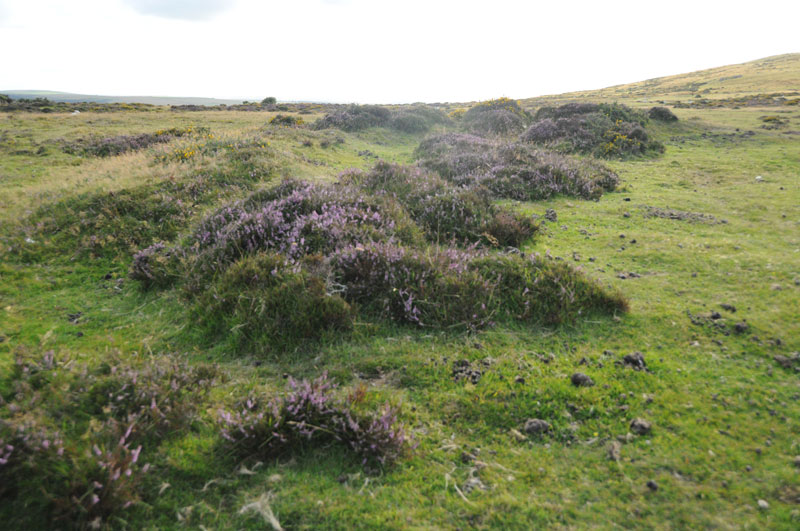
Glyn Gath Barrow submitted by Anne T on 27th Aug 2014. Standing on the bank at the edge of Glyn Gath ring cairn looking northwest.
(View photo, vote or add a comment)
Log Text: Glyn Garth Ring Cairn, Pembrokeshire: After visiting a series of standing stones on the northern side of the Afon Gwaun river, we headed eastwards back towards the hotel at Gellifawr. We passed directly by the Glyn Garth ring cairn, so stopped to take a look.
Even with a detailed map, without the marker stone, we wouldn’t have been able to easily identify this cairn, but walking into the heather and gorse we could make out the perimeter banks (easier to do this with the eye than demonstrate with the camera – I’ve yet to learn the technique to do this well).
It was an impressive location; With Myndd Dinas behind and Newport Bay to the north, this was a fantastic place to be buried.
On the drive southwards from Glyn Garth to Pontfaen, we were doing double-takes at most field entrances, as the gateposts all seemed (to our novice eyes) to be standing stones which had been perhaps been relocated and recycled.
Also of notes to future visitors, it is well worth popping into the Dyffryn Arms at Pontfaen. It is like walking back into time; the main bar is like small sitting room from the 1930s and the landlady serves ale from jugs from a serving hatch – brilliant!
St Gwyndaf Stones
Date Added: 28th Aug 2014
Site Type: Early Christian Sculptured Stone
Country: Wales (Pembrokeshire)
Visited: Yes on 22nd Aug 2014. My rating: Condition 3 Ambience 4 Access 4

St Gwyndaf Stones submitted by vicky on 8th Jun 2004. One of the five 7th-9th century decorated stones in the exterior walls of Llanwnda Church. This one is decorated with a face beneath the cross of St Andrew.
(View photo, vote or add a comment)
Log Text: St Gwyndaf’s Church, Llanwnda with stone crosses: Husband, Andrew, and I were both intrigued by Vicky’s description of the St. Gwyndaf Stones on the Portal, so after a busy day exploring the St David’s area, we decided to stop off in Fishguard for dinner, taking a detour to Llanwnda on the way.
Despite having a detailed map, we got lost twice, taking the wrong lane and ending up back on the main road, then taking the left hand turn inside of the right where the road splits within Llanwnda village, and ending up at someone’s house and having to reverse down a particularly narrow, windy single track lane, being watched by a curious local lady who came out to watch.
After that, we found the church easily enough. There were even a few parking spaces just by the path leading down to the church. A very pretty spot, although feeling incredibly remote, overlooking the sea.
The whole of this site has a huge sense of age and heritage. The inside of the church is simple, but impressive. There was no church guide available to look at, but there was a copy of the ‘Saints and Stones’ book telling us something about the church. Page 7 of this books tells us: “on the window-sill near the font is a fragment of a medieval stone showing a bishop administering a blessing and holding a staff; it may have been part of an ancient churchyard and cross. Another stone fragment of the same date can be seen on the first window-sill in the south wall. In the chancel is a case containing a copy of the Welsh ‘Parry’ Bible (1620) [although this is well-used and falling apart – impressive non-the-less] .... No fewer than six 7th-9th century Christian marked stones were also discovered in 1881; five of them are set into the exterior walls of the church. Once part of the larger structures, they were carved by stonemasons working under monastic patronage. The most fascinating of these is set into the east end of the south transept. It shows a rudely incised face surrounded by four parallel lines beneath the cross of St. Andrew; the face may be that of a female, a monk or Christ-as-Procrator. High in the south wall is a stone marked with a double-outline cross and another in the east wall of the chancel is decorated with a Latin cross. A fourth stone in the north wall displays a double Latin cross enclosed by a rounded outline, and low in the south wall to the west of the porch is a stone of later date (probably 10th century) with a moulded cross. The base of a decorated cross lies on the north-west side of the churchyard.”
We spotted the five stones set in the wall and the two on the window-sills, but failed to see the cross in the churchyard.
I’d recommend anyone in the area to take an hour to find this church and the stones – a true sense of history and occasion contained within this tiny building and surrounding church yard.
On the next visit, must ensure to take in the Garnwnda Burial Chamber and nearby standing stone.
Pentre Ifan
Date Added: 27th Aug 2014
Site Type: Portal Tomb
Country: Wales (Pembrokeshire)
Visited: Yes on 23rd Aug 2014. My rating: Condition 3 Ambience 5 Access 4

Pentre Ifan submitted by PaulM on 24th Aug 2001. PENTRE IFAN CHAMBERED LONG CAIRN WITH FORECOURT
NGR: SN09953702 (Landranger map 145/Outdoor Leisure North Pembrokeshire map (No 35))
Located 4km east of Newport on a public footpath. One of the most spectacular and famous monuments of its type it consists of a tilted capstone perched on three uprights. A blocking stone obstructs the doorway and a semi-circular forecourt is found at the southern end. Originally covered by a huge long mound - traces of possible kerbstones can still be fou...
(View photo, vote or add a comment)
Log Text: Pentre Ifan, Pembrokeshire: I was particularly excited to go to the site, as I’d seen many photographs and paintings of Pentre Ifan during our brief visit to Pembrokeshire, together with photographs on the Portal. I was unprepared for the sheer number of visitors who came to see this spectacular burial chamber. However, everyone seemed to respect others need to take photographs and kept out of each other’s way, which was nice. We also got into conversation with a Japanese lady about how they had raised the cap stone.
I was truly amazed at how the cap stone balances on the pointed tips of just three uprights. All around are larger stones which may have been part of the structure in the past.
The views over to Newport sands and the sea are wonderful. I would like to go back to the site at a quieter time and just sit and absorb it.
The Pillar Stones
Date Added: 27th Aug 2014
Site Type: Early Christian Sculptured Stone
Country: Wales (Pembrokeshire)
Visited: Yes on 21st Aug 2014. My rating: Condition 3 Ambience 4 Access 5

Pillar Stones submitted by PaulM on 24th Apr 2003. The Pillar Stones are a group of four Christianised stones located in a churchyard in the Gwaun Valley in Pembrokeshire (SN123340).
The reverse of each of the stones is carved a cross of differing designs. A fifth stone seems to act as a font.
(View photo, vote or add a comment)
Log Text: Pillar Stones, Cwm Gwaun. These stones were the second of the ancient monuments we saw during our visit to Pembrokeshire, and a great start to our trip.
The five pillar stones were visible from the road, in the grounds of a small chapel, so we parked in the driveway to get off the single track road. It was only when we tried to go into the chapel that we realised it had been converted to a private house and the pillar stones were in the garden.
We were able to make our crosses on three of the stones (inscribed on the sides facing away from the chapel, looking east). I wasn’t sure if there was any particular alignment to the stones; they didn’t particularly appear to have been arranged in rows.
There is also an old font under the bell tower of the church.
Trefach
Date Added: 27th Aug 2014
Site Type: Standing Stone (Menhir)
Country: Wales (Pembrokeshire)
Visited: Yes on 21st Aug 2014. My rating: Condition 3 Ambience 4 Access 4

Trefach submitted by PaulM on 6th Jan 2003. The Trefach Stone.
Please see the Megalith Map site entry for details.
(View photo, vote or add a comment)
Log Text: Trefach, Pembrokeshire. This stone was literally just round the corner from Gellifawr, where we were staying. We parked at the entrance to the field on the corner of the road and walked up to the footpath which leads up to Waun Mawn. There was actually a couple of parking spaces at the bottom of the footpath so we could have driven closer, but after a long car journey, it was nice to put feet to tarmac and grass again.
The footpath rises up a gentle hill, and after a few paces, there was what appeared to be a cairn to the left hand side. Looking up the hill, Trefach became visible on the horizon. There was a clear track leading up to the stone, so we followed this. The stone is surrounded by a low wire fence, presumably to protect it from the stock (in this case a small herd of Welsh ponies, who curiously came to see what we were doing and what food we might have brought!).
The views over the Afon Gwaun Valley to the east were lovely. (as Paul M says in his description of the site: ‘commanding’). To the north west, there were views over crags at what I think is Carn Ingli.
Near the main Trefach stone, there was a fallen stone, which looked as if it might have stood upright. The field was also littered with groups of stones which looked like possible cairns.
This was the start of a couple of hours exploring some pretty interesting sites within the Cwm Gwaun valley.
